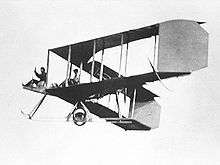Burgess Company
The Burgess Company was a U.S. airplane manufacturer between 1910 and 1918.
 A Burgess-Dunne, based on a previous design, the Dunne D.8 | |
| Industry | Aerospace |
|---|---|
| Successor | Curtiss Aeroplane and Motor Company |
| Founded | 1910 |
| Founders |
|
| Defunct | 1918 |
| Headquarters | |
History
The business was incorporated in 1910 as the "Burgess Company and Curtis, Inc." (after W. Starling Burgess and Greely S. Curtis, its co-founders with Frank Henry Russell). The company was an offshoot of the W. Starling Burgess Shipyard, of Marblehead, Massachusetts.
Burgess was the first licensed aircraft manufacturer in the United States. On February 1, 1911, it received a license to build Wright aircraft from the Wright Brothers, who held several key aeronautical patents. Burgess was charged licensing fees of $1000 per aircraft and $100 per exhibition flight.[1] In 1912 Burgess fitted some of its Wright Model F airplanes with pontoons, contrary to the Wright Company's licensing provisions, which permitted only exact copies of their designs. The license agreement was terminated by mutual consent in January 1914.
In the same month, January 1914, the organization became the Burgess Company, a name change to avoid confusion with the Curtiss Aeroplane and Engine Company. Greely S. Curtis continued as Treasurer and its major shareholder. Burgess designed and flight tested most of the aircraft that were manufactured at the two plant sites in Marblehead. Curtis was the company's financial and engineering adviser and Russell, formerly the manager of the Wright Company's Dayton factory, managed their production operations. The Burgess Company was acquired on February 10, 1914 by the Curtiss Aeroplane and Motor Company. The Burgess Company then operated as a manufacturing subsidiary producing Curtiss's naval training aircraft in late 1916 and continued to produce these aircraft under the Burgess name during World War I until its main production facility was totally destroyed by fire on November 8, 1918.
The company provided seaplanes and other aircraft to the military. The first tractor configuration airplane purchased by the U.S. Army was a Burgess H (S.C. No. 9) in August 1912. In September 1913, a Burgess Model F seaplane based on a modified Wright Model B design with pontoons, was delivered to the Signal Corps for use in the Philippines to maintain a flying school. The same aircraft (S.C. No. 17) in December 1914 was the first in the Army to demonstrate two-way air-to-ground radio communications.
Aircraft
| Model name | First flight | Number built | Type |
|---|---|---|---|
| Herring-Burgess A | 1910 | 5 | Pusher biplane |
| Burgess Model B | 1910 | 1 | Pusher biplane |
| Burgess Model C | 1910 | 1 | Pusher biplane |
| Burgess Model D | 1910 | 1 | License built Curtiss Model D |
| Burgess Model E | 1911 | 7 | License built Grahame-White Baby |
| Burgess Model F | 1911 | ~60 | License built Wright Model B |
| Burgess Model G | N/A | 0 | Unbuilt modified Wright Model B |
| Burgess Model H | 6 | Training biplane | |
| Burgess Model I | 1913 | 1 | Reconnaissance floatplane |
| Burgess Model J Scout | 1 | Modified Wright Model C with curved wings | |
| Burgess Model K | 1913 | 1 | Pusher biplane flying boat |
| Burgess-Dunne Model BD | 1914 | 26 | Tailless biplane |
| Burgess Model O Gunbus | 1915 | 36 | Pusher biplane fighter |
| Burgess Model S | 1916 | 6 | Biplane flying boat |
| Burgess Model U | 1 | Biplane floatplane | |
| Burgess Twin Hydro | 1917 | 1 | Twin engine biplane floatplane |
| Burgess Model HT-1 | 1917 | 2 | Sesquiplane floatplane tractor biplane |
| Burgess Model HT-2 Speed Scout | 6 | Experimental floatplane biplane fighter/observation airplane | |
| Burgess Model N-9 | 460 | License built Curtiss Model N | |
See also
References
- Howard Mansfield. Skylark: the life, lies, and inventions of Harry Atwood. p. 13.
Bibliography
- Deane, William J. (2009). "The Burgess Company". The Massachusetts Aviation History Society. Archived from the original on 28 March 2016. Retrieved 14 January 2020.
- Eckland, K. O. (13 October 2008). "Burgess, Burgess-Dunne, Burgess-Gill, Burgess-Wright, Herring-Burgess". Aerofiles. Retrieved 14 January 2020.
- Rumerman, Judy. "The First U.S. Aircraft Manufacturing Companies". U.S. Centennial of Flight Commission. Archived from the original on 10 October 2012. Retrieved 14 January 2020.
External links
| Wikimedia Commons has media related to Burgess Company. |